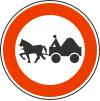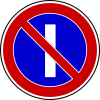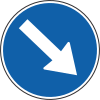Road signs in Serbia: Difference between revisions
No edit summary |
edited Tags: Visual edit Mobile edit Mobile web edit |
||
| Line 147: | Line 147: | ||
File:E70-SRB.svg|European road |
File:E70-SRB.svg|European road |
||
File:Serbia road sign III-68 (new).svg|Motorway |
File:Serbia road sign III-68 (new).svg|Motorway |
||
File: |
File:MK road sign 351.1.svg|End of motorway |
||
File:Serbia road sign III-21.svg|Expressway |
File:Serbia road sign III-21.svg|Expressway |
||
File:Serbia road sign III-22.svg|End of expressway |
File:Serbia road sign III-22.svg|End of expressway |
||
Revision as of 20:25, 6 May 2024

The road signs, used on the Serbian road network, are regulated by the "Regulation of Traffic Signs" (Serbian Cyrillic: Правилник о саобраћајној сигнализацији, Serbian: Pravilnik o saobraćajnoj signalizaciji), which was last time modified in 2017.[1]
The road signs follow the Vienna Convention on Road Signs and Signals of 1968, and the former Yugoslav standard road signs, used by the successor states of SFR Yugoslavia. Inscriptions are in both Cyrillic and Latin alphabets. The SNV typeface is used on Serbian road signs as well as in other former Yugoslav states and neighboring Bulgaria and Romania. They are also used in Kosovo, although some of these signs were superseded by the Albanian road sign system, itself a copy of the Italian road sign system. In Montenegro, these road signs are only written in the Latin script since it became an independent state in 2006.
Category A: Warning signs
-
Curve to left
-
Curve to right
-
Double curve, first to left
-
Double curve, first to right
-
Dangerous curves ahead
-
Steep uphill
-
Steep downhill
-
Road narrows
-
Road narrows on right side
-
Road narrows on left side
-
Drawbridge
-
Quayside or riverbank
-
Uneven road
-
Dip
-
Bump
-
Slippery road
-
Loose gravel
-
Falling rocks
-
Falling rocks
-
Pedestrian crossing
-
Children
-
Cyclists
-
Animals
-
Wild animals
-
Roadworks
-
Traffic light
-
Traffic light
-
Low-flying aircraft
-
Crosswinds from left
-
Crosswinds from right
-
Two-way traffic
-
Tunnel
-
Other dangers
-
Intersection with right-priority rule
-
Intersection on a priority road with a non-priority road
-
Intersection on a priority road with a non-priority road from left
-
Intersection on a priority road with a non-priority road from right
-
Merging traffic from left
-
Merging traffic from right
-
Oblique side road with priority, from the left
-
Oblique side road with priority, from the right
-
Roundabout
-
Tramway
-
Level crossing with barriers ahead
-
Level crossing without barriers ahead
-
Single track level crossing
-
Multi-track level crossing
-
Distance panels for level crossing with barriers
-
Distance panels for level crossing without barriers
-
Pedestrians
-
Soft verges
-
Traffic queues
Category B: Prohibitory signs
-
Give way
-
Stop
-
All vehicles prohibition in both directions
-
No entry
-
No motor vehicles, expect motorcycles
-
No buses
-
No trucks
-
No vehicles carrying dangerous water pollutants
-
No vehicles carrying explosives
-
No vehicles carrying dangerous goods
-
No articulated vehicles
-
No tractors
-
No motorcycles
-
No mopeds
-
No bicycles
-
No animal-drawn vehicles
-
No handcarts
-
No pedestrians
-
No motor vehicles
-
No motor and animal-drawn vehicles
-
No buses, tractors and animal-drawn vehicles
-
Maximum width
-
Maximum height
-
Maximum weight
-
Maximum weight per axle
-
Maximum length
-
Minimum safe distance
-
No left turn
-
No right turn
-
No U-turn
-
No overtaking
-
No overtaking by trucks
-
Maximum speed limit
-
No horns
-
Customs
-
Police
-
Toll
-
Give way to oncoming traffic
-
No stopping
-
No parking
-
No parking in odd days
-
No parking in every days
Category C: Mandatory signs
-
Minimum speed limit
-
Snow chains mandatory
-
Bike path
-
Pedestrian path
-
Pedestrian and bike path
-
Pedestrian and bike path
-
Trail for riders
-
Proceed straight
-
Turn right
-
Turn left
-
Turn left ahead
-
Turn right ahead
-
Proceed straight or turn left
-
Proceed straight or turn right
-
Turn left or right
-
Pass onto left
-
Pass onto right
-
Pass either side
-
Roundabout
Category D: Information signs
-
Priority over oncoming traffic
-
One-way street
-
One-way street
-
Priority road
-
End of priority road
-
Pedestrian crossing
-
Underground or overground pedestrian passage
-
Dead end
-
The road of movement of the vehicle to the intersection where it is forbidden to turn left
-
Uses of lanes at an intersection
-
County road number
-
Secondary road number
-
Marker of the section of the county road
-
European road
-
Motorway
-
End of motorway
-
Expressway
-
End of expressway
-
Built-up area on a highway
-
Built-up area
-
End of built-up area on a highway
-
End of built-up area
-
End of overtaking prohibition
-
End of overtaking by trucks prohibition
-
End of speed limit
-
End of minimum speed limit
-
End of using horns prohibition
-
End of previous prohibitions
-
End of snow chains mandatory
-
End of bike path
-
End of pedestrian path
-
End of trail for riders
-
End of pedestrian and bike path
-
End of pedestrian and bike path
-
No parking zone
-
End of no parking zone
-
Parking
-
Parking garage
-
Parking time limit
-
Park and ride
-
Hospital
-
First aid
-
Breakdown service
-
Telephone
-
Petrol station
-
Hotel or motel
-
Restaurant
-
Café
-
Park
-
Camping for tents
-
Camping for caravans
-
Camping for tents and caravans
-
Vila
-
Road assistance
-
Fire extinguisher
-
Bus stop
-
Tram stop
-
Airport
-
Port
-
Information
-
Passability of the road
-
Serpentine number
-
Tunnel
-
Altitude of the pass
-
River
-
Police station
-
Recommended speed limit
-
Street sign
-
Chevrons
-
Chevrons
-
Chevrons
-
Chevrons
-
Exit sign
-
Children
-
Lane for buses
-
End of lane for buses
-
National speed limits
-
Third lane
-
End of third lane
-
Pedestrian zone
-
End of pedestrian zone
-
Speed limit zone
-
End of speed limit zone
-
Bump
-
Danger
-
Living street
-
End of living street
-
School zone
-
End of school zone
-
Alternating passing of vehicles
-
Intermittent passing of vehicles
-
Emergency exit
-
Emergency exit
-
Distance to the emergency exit
-
Distance to the emergency exit
-
Speed control
-
Preliminary direction indicator (option 1)
-
Preliminary direction indicator (option 2)
-
Preliminary direction indicator (option 3)











































































































































































































